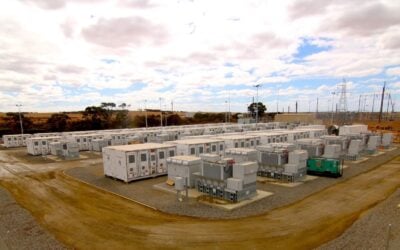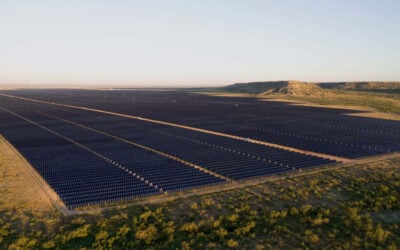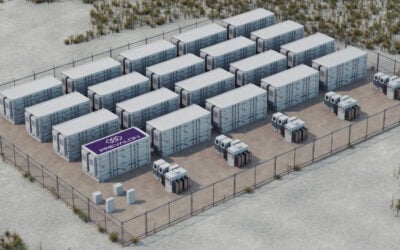

The new edition of UL9540A aims to further enhance battery storage fire safety at an industry-wide level, and more technology providers have conducted large-scale fire testing (LSFT).
Updated UL9540A thermal runaway propagation test
UL Solutions has updated its fire safety testing for battery storage to reflect changes to the UL9540A test method.
Enjoy 12 months of exclusive analysis
- Regular insight and analysis of the industry’s biggest developments
- In-depth interviews with the industry’s leading figures
- Annual digital subscription to the PV Tech Power journal
- Discounts on Solar Media’s portfolio of events, in-person and virtual
Or continue reading this article for free
The move by the commercial arm of Underwriters Laboratory (UL) follows the recent publication of the fifth edition of UL9540A, which is the standard test for evaluating the risks of thermal runaway propagation in battery energy storage systems (BESS).
The test method was first developed in 2017. The fourth edition was published in 2019, and the energy storage industry has widely adopted it to evaluate the risks of thermal runaway induced in a single battery cell.
It evaluates the likelihood of thermal runaway occurring through different means, such as physical abuse or short circuits, and the chances of fire spreading once it does occur.
It is the national standard for thermal runaway evaluation in the US and Canada. It is integral to various industry standards such as NFPA 855 (Standard for the Installation of Stationary Energy Storage Systems from the National Fire Protection Association) and UL9540 (Standard for Energy Storage Systems and Equipment).
BESS companies often publicise their test results to indicate the safety of their solutions. While there is no pass/fail criteria, detailed explanations of results are often made public.
The latest edition of ANSI/CAN/UL 9540A, the Standard Test Method for Evaluating Thermal Runaway Fire Propagation in Battery Energy Storage Systems, to give it its full name, was published by UL Standards & Engagement in March.
UL Standards & Engagement collaborated with industry stakeholders, representatives of regulatory organisations, and other members of the UL9540A technical committee to align the standard with the latest technology and best practices, as mentioned in an FAQ page on the UL website..
UL Solutions noted in an announcement on Sunday (20 April) that the new edition includes clearer criteria for evaluating cell-to-cell propagation, while other changes include a requirement for results from previous tests in module, unit and installation level testing to be provided. It also introduces test criteria for non-lithium technologies including sodium-ion and flow batteries, and UL Solutions said its testing method has been likewise enhanced to offer evaluations of those technologies.
Large-Scale Fire Testing addresses ‘gap’
UL9540A will also be included in the forthcoming 2026 edition of NFPA 855 which, while pertaining to a US standard for fire safety, is also widely adopted around the world.
The thermal runaway test has been included in previous iterations, but one significant change expected in NFPA 855 2026 is the inclusion of requirements for Large-Scale Fire Testing in some circumstances.
This basically means a full BESS enclosure or sometimes multiple enclosures are set on fire and allowed to burn and the results observed, with all fire suppression equipment switched off. It is designed to replicate a real-world worst-case scenario fire event and so far, Energy-Storage.news has reported on LSFT being carried out by technology providers, including Fluence, Sungrow, Wärtsilä and Trina Storage, although several others are also known to have conducted similar tests.
Most, if not all, of those tests have been undertaken in line with TS-800, a new LSFT standardised procedure to observe and document the effects of fire on battery storage equipment, developed by testing and certification laboratory CSA Group.
CSA Group, which is designated as a Nationally Recognized Testing Laboratory in the US, hosted a webinar with Energy-Storage.news in November last year explaining the need for LSFT and how TS-800 works.
“Put simply, the purpose of Large-Scale Fire Testing is to intentionally ignite a fire within a single energy storage system unit and see how it might spread to nearby systems or the environment,” Michael Becker, global business head for energy storage, energy & power at CSA Group said in the webinar.
“This is really critical for utility-scale projects that have multiple energy storage system units installed next to each other.”
Prevalon performs TS-800 procedure
In the past few days, BESS system integrator Prevalon Energy and its contract manufacturer CLOU Electronics announced that their products have recently undergone the LSFT procedure in accordance with TS-800.
Prevalon Energy, the BESS technology platform spinout from Mitsubishi Power Americas, completed the test on its HD5 modular AC battery system. Four units were arranged in a standard back-to-back and side-by-side configuration and one unit was fully set on fire.
Prevalon reported that the fire was contained to a single unit. There was no impact on adjacent units, all the battery modules inside remained below critical thermal thresholds.
In a separate announcement on the same test procedure, CLOU Electronics, a subsidiary of Chinese electrical appliance manufacturer Midea Group, offered more details.
It said temperatures inside the 5MWh system, which CLOU manufactures and markets under its own brand name Aqua C2.5, were more than 1000°C and the ignited unit burned for more than 48 hours.
All four 20ft units were placed near one another to replicate real site conditions and were fully charged.
CLOU energy storage system division director Eric Wang said the Aqua C2.5 is the world’s first large-scale storage system equipped with an active ventilation fire protection design.
“Through active cell sensing, it triggers an electric shutter explosion suppression solution in thermal runaway scenarios, effectively controlling the spread of thermal runaway at extreme short distances in 140mm,” Wang said.
“The existing standards (such as UL 9540A) are capable of testing for thermal runaway, but they do not adequately simulate fire propagation scenarios, especially in multi-module container systems where a single battery fire can potentially ignite adjacent units or even the entire system,” Marvin Peng, battery & energy storage certifier at CSA Group said after the test, which was conducted in February.
“The core goal of the TS-800 test is to address this gap.”
Watch the Energy-Storage.news webinar with CSA Group, Evolving large-scale fire testing requirements for battery energy storage systems.






